The inverter is the most critical part of the solar system. Solar panels produce DC output. The inverter converts it into usable AC power. The inverter is also used to monitor the system to analyze its performance.

The central inverter is suitable for large-scale solar equipment. Like string inverters, central inverters are also attached to the strings of the panel, but they can support a large number of strings. There is a central inverter, all the panel strings are connected in a box, from which a DC output is generated and fed into a central inverter, which converts it into usable AC power.
A hybrid inverter is a unit that combines the inverter and the battery. They are bidirectional and require batteries to work.
The individual solar panels are connected in a series called "strings". Multi-string and single-string inverters are linked. The inverter converts direct current into usable alternating current and uses it as electricity in the home.
Each solar panel has a small inverter directly connected to it, called a microinverter. Since each panel works independently, it is very suitable for roofs with complex layouts and shading issues.